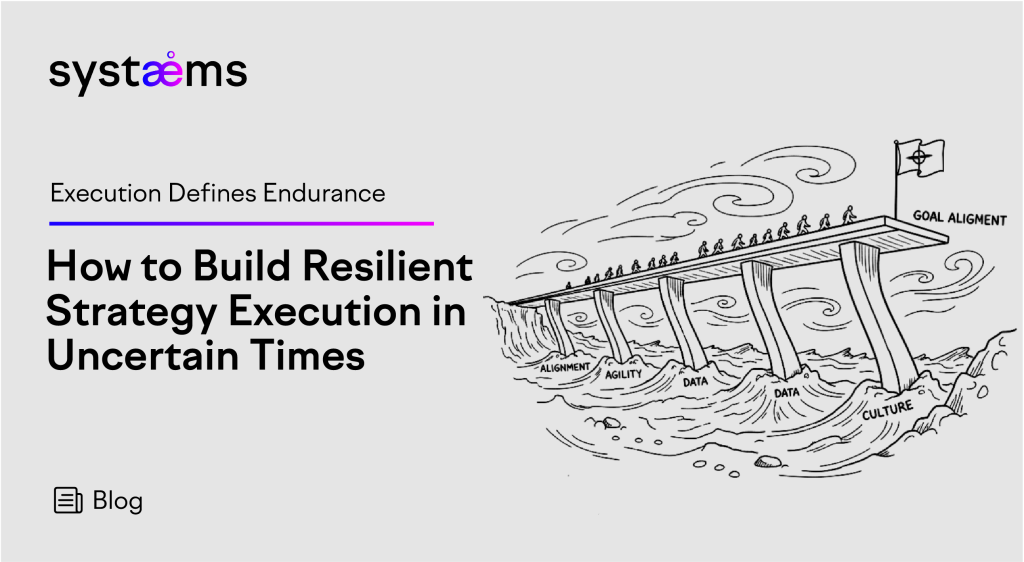Embedding ESG into Performance Management for Growth
Integrate ESG KPIs into performance management to drive sustainable growth and measurable impact.

Uncertainty has become the new normal. Organizations today must contend with economic turbulence, geopolitical risks, technological disruption, and shifting regulatory landscapes. While many businesses excel at developing ambitious strategies, research consistently shows that execution remains the critical bottleneck. A well-crafted strategy that cannot be implemented effectively delivers little value.
Resilient strategy execution is about more than following a plan. It requires alignment, agility, data-driven insights, and cultural strength. The organizations that can monitor, adapt, and refine execution in real time will thrive in today’s volatile environment. This article explores the pillars of resilient strategy execution, why strategies often fail, and how leaders can embed adaptability into performance management frameworks.
Even with the best intentions, many strategies never translate into meaningful outcomes. Studies suggest that 70% of strategic initiatives fall short during execution, highlighting an enduring gap between vision and results.
Common pitfalls include:
As industry analyses confirm, consulting firms are increasingly valued not for drafting strategy documents but for providing execution frameworks that deliver measurable outcomes.
1. Alignment Across the Organization
Resilient execution begins with alignment. Strategic intent must cascade from leadership vision to departmental goals and finally to individual performance indicators. Frameworks like the Balanced Scorecard and KPI-driven cascades help connect strategy to daily activities. For modern performance management requiring agility and resilience, the Objectives and Key Results (OKR) framework is often more effective than the traditional Balanced Scorecard (BSC). Its shorter, typically quarterly cycles allow the PMO to review and adapt strategy with greater speed and flexibility.
Systaems’ Strategy and Business Planning services provide structured methodologies to ensure such alignment. By translating vision into clear, measurable objectives, organizations foster a unified approach to execution.
Alignment is not a one-off exercise. When leaders consistently integrate goals across all levels, strategy becomes part of everyday decision-making.
2. Agile Planning and Adaptability
Rigid strategies often collapse under pressure. To remain resilient, organizations must adopt continuous planning cycles rather than relying on static annual reviews. Agile planning allows teams to adjust priorities when confronted with market shocks, regulatory changes, or technological advances.
Systaems supports this shift through its performance management consulting, embedding feedback loops that ensure plans evolve alongside external conditions.
A resilient strategy is one that breathes. Consultants who integrate agility into planning help organizations thrive in turbulence, not just survive it.
3. Data-Driven Decision Making
Data is the backbone of resilient execution. Organizations that rely on intuition alone risk making delayed or misinformed decisions. By contrast, firms that use real-time dashboards, validated KPIs, and predictive analytics can respond faster and more effectively.
Systaems’ Data Services provide comprehensive solutions for data collection, governance, validation, and visualization. With these systems in place, decision-makers gain access to insights that allow them to adjust strategies proactively.
Numbers tell a story. The organizations that learn to read and act on that story will always be a step ahead.
4. Leadership and Cultural Enablers
To enable resilient strategic execution, organizations must fundamentally shift their culture: from Management for Control to Management for Learning. A learning-oriented culture is the key enabler that allows strategies to adapt and thrive in the face of uncertainty. Processes and systems alone cannot ensure execution. Resilient organizations are built on a culture of accountability, transparency, and continuous learning. Strong leaders communicate intent clearly, engage employees, and model adaptability.
Employee performance management frameworks reinforce this by linking individual contributions to strategic priorities. When employees see the connection between their work and broader organizational goals, engagement rises and execution becomes more effective.
Culture eats strategy for breakfast. Embedding resilience into execution requires leaders who embody adaptability and empower their teams to do the same.
Organizations seeking to strengthen their execution capabilities can follow a structured roadmap:
Systaems provides integrated solutions that combine strategic planning, audit services, and operational performance management, enabling organizations to follow this roadmap with confidence.
A practical example of resilient execution comes from Pengurusan Aset Air Berhad (PAAB). PAAB faced challenges with data overload and fragmented reporting, which limited its ability to track strategic outcomes effectively.
Through collaboration with Systaems, PAAB implemented performance dashboards that emphasized outcomes rather than outputs. This shift allowed leaders to make decisions that improved efficiency, compliance, and operational resilience.
By embedding resilience into its strategy execution, PAAB positioned itself to deliver sustained value even in uncertain operating conditions. To explore more examples of how Systaems has enabled organizations to achieve their goals, visit our Success Stories page.
Resilient strategy execution is not a one-off initiative. It is an ongoing discipline that blends alignment, agility, data-driven insights, and cultural strength. In times of uncertainty, organizations that execute well do more than survive; they position themselves to thrive.
By leveraging expertise in performance measurement consulting, data management and analysis, and operational excellence, consulting partners such as Systaems enable organizations to convert strategic intent into tangible results, even in the most uncertain times.
👉 Ready to build resilience into your strategy execution? Speak with a consultant today.
Integrate ESG KPIs into performance management to drive sustainable growth and measurable impact.
Explore how data, agility, and performance alignment shape the next era of consulting excellence.
Align consulting fees with results using outcome-based pricing to drive value and accountability.
